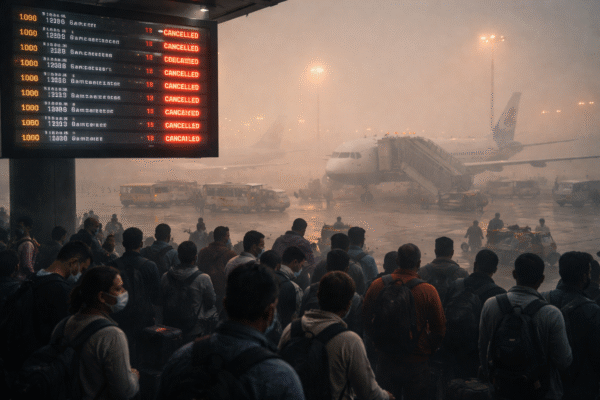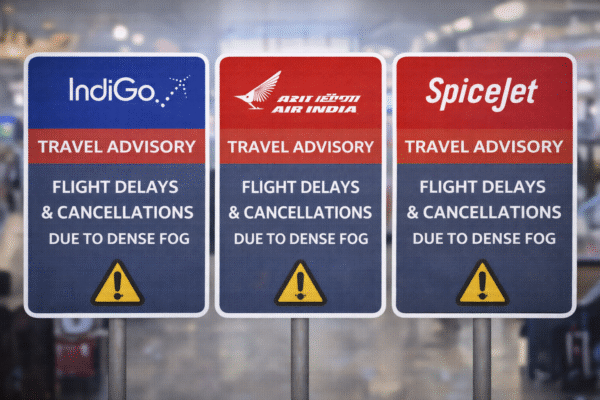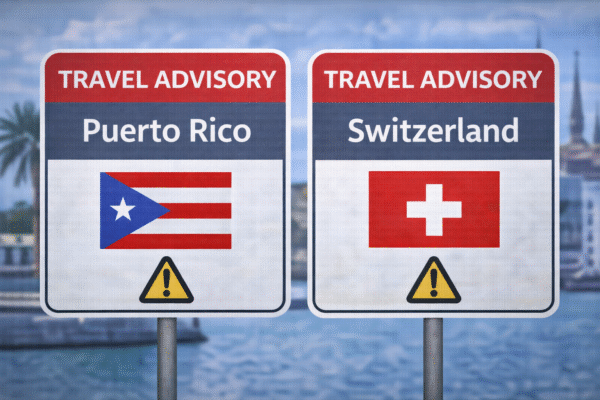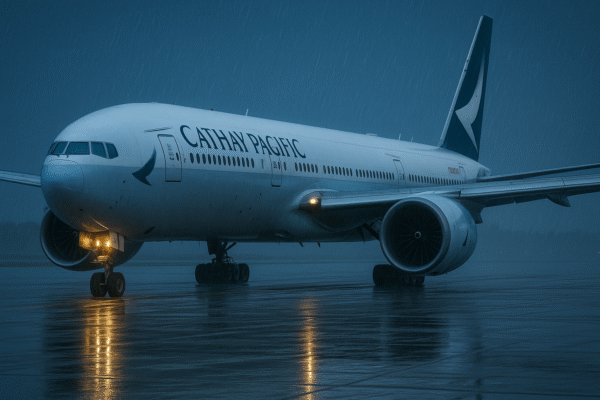What was supposed to be a smooth transpacific journey turned into one of the longest and most exhausting travel sagas in recent memory. On August 4, 2025, Cathay Pacific flight CX883 from Los Angeles International Airport (LAX) to Hong Kong International Airport (HKG) was severely disrupted when a Black Rainstorm Warning was issued in Hong Kong.
The weather alert, the highest level in Hong Kong’s warning system, forced the Boeing 777-300ER to divert to Taipei Taoyuan International Airport (TPE). For the 294 passengers onboard, the 13.5-hour journey stretched into a marathon 29-hour ordeal—with over 10 hours of waiting on the tarmac in Taipei before finally arriving in Hong Kong.
What Is a Black Rainstorm Warning?
Hong Kong’s Black Rainstorm Warning system signals extreme rainfall exceeding 70 millimeters per hour, posing major threats to infrastructure, transportation, and public safety. According to the Hong Kong Observatory (HKO), this August storm delivered record-breaking rainfall of more than 350 millimeters in less than 24 hours, making it the wettest day since 1884.
Flights were grounded, public transport halted, and flash floods disrupted daily life. For Cathay Pacific, it meant that dozens of flights were delayed, canceled, or rerouted—including the heavily impacted CX883.
The Unexpected Detour to Taipei
The CX883 aircraft reached Hong Kong airspace after nearly 13 hours of flying, but heavy rain, reduced visibility, and unsafe runway conditions forced air traffic control to deny landing clearance. The flight was rerouted to Taipei, where it landed at 5:30 AM local time.
Passengers expected to disembark temporarily, but immigration restrictions prevented entry since Taipei was not an official destination. Instead, travelers were kept onboard for an additional 10.5 hours, waiting for clearance, fresh crew, and improved weather in Hong Kong.
As the hours passed, frustration grew. Families, elderly passengers, and business travelers voiced concerns about lack of clear communication, limited food supplies, and the psychological toll of being confined in the aircraft.
Why Passengers Couldn’t Leave the Aircraft
Cathay Pacific later explained that international aviation laws prevented unscheduled disembarkation without special authorization. Immigration authorities in Taipei could not process nearly 300 travelers without prior arrangements.
Additionally, the flight crew had exceeded duty-hour limits, requiring replacements before resuming operations. Arranging new pilots and cabin staff further delayed the flight’s onward journey.
Passengers Question Airlines’ Preparedness
The incident raised significant questions about passenger rights and airline preparedness for extreme weather disruptions:
- Should passengers have been allowed into the terminal during the long delay?
- Could Cathay Pacific have better coordinated with Taipei airport authorities?
- What compensation will affected passengers receive under international aviation rules?
Many travelers expressed concern about being left “in the dark,” with minimal updates. Aviation experts argue that airlines must adopt stronger contingency plans, especially as climate change increases the frequency of extreme weather events in Asia-Pacific.
Health Risks of Long Flight Delays
Being confined in an aircraft for nearly 29 hours poses not just discomfort, but potential health risks. Extended immobility can increase the chances of deep vein thrombosis (DVT), dehydration, and heat exhaustion if cabin conditions are not managed carefully.
Medical professionals stress the importance of airlines ensuring adequate food, water, ventilation, and communication during extended tarmac delays. For passengers, carrying hydration, snacks, medication, and power banks can help prepare for unexpected disruptions.
How Travelers Can Prepare for Extreme Weather Delays
- Check Weather Warnings: Before departure, monitor official sources such as the Hong Kong Observatory, Taiwan Central Weather Bureau, and airline updates.
- Know Passenger Rights: The U.S. Department of Transportation (DOT) and EU Regulation 261/2004 outline rights to compensation and care during delays. While Hong Kong and Taiwan have different frameworks, Cathay Pacific has a customer service obligation.
- Pack Essentials: Snacks, refillable water bottles, chargers, and medications are crucial during long-haul flights.
- Stay Calm & Informed: Communication with airline staff is key. Passengers who remain calm and document delays are better positioned for successful claims.
- Plan for Flexibility: When traveling during storm season in Asia, build flexibility into itineraries. Consider insurance that covers weather-related delays.
Hong Kong’s Ongoing Struggle with Extreme Weather
This Black Rainstorm event is the latest in a series of extreme weather disruptions affecting Hong Kong’s tourism and aviation sector. In recent years, typhoons, flooding, and rising temperatures have increasingly affected air travel in the region.
Tourism officials emphasize that while Hong Kong remains one of Asia’s premier destinations, climate resilience must be improved to ensure visitor safety and confidence.
Cathay Pacific’s Next Steps
Cathay Pacific has pledged to review emergency procedures and explore ways to reduce passenger discomfort in future diversions. The airline acknowledged the ordeal and promised assistance for compensation claims.
For passengers of CX883, the incident was a stark reminder of the unpredictability of modern air travel. While aviation remains one of the safest modes of transport, weather disruptions are becoming more frequent, requiring airlines and governments to adapt quickly.
Conclusion
The 29-hour delay of Cathay Pacific flight CX883 due to Hong Kong’s Black Rainstorm Warning highlights the growing intersection between climate change and global tourism. For travelers, it is both a cautionary tale and a reminder to travel prepared. For airlines, it underscores the urgent need to balance safety, passenger rights, and operational resilience.
As Hong Kong continues to battle extreme weather, one lesson remains clear: in the face of storms, both passengers and airlines must learn to adapt to ensure safe skies and secure journeys.
For more travel news like this, keep reading Global Travel Wire
















